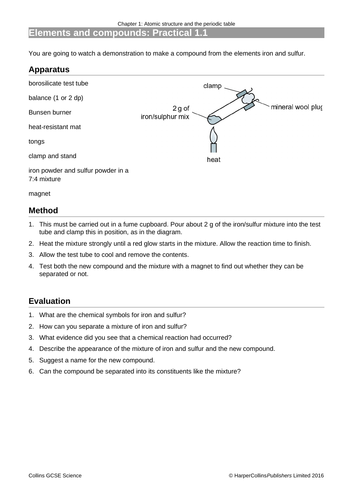



















































AQA (9-1) 4.1 Atomic structure and the periodic table:
4.1.1.1 Atoms, elements and compounds
4.1.1.2 Mixtures
4.1.1.3 The development of the model of the atom (common content with physics)
4.1.1.4 Relative electrical charges of subatomic particles
4.1.1.5 Size and mass of atoms
4.1.1.6 Relative atomic mass
4.1.1.7 Electronic structure
Content split over 10 lessons (lessons in our school are 40 minutes so can condense material for longer lessons)
All exam questions have been removed for copyright purposes
All extension questions available on each slide
Answers all underneath each slide
Support also available where necessary
AfL sections and mini quizzes
Reducing the need for photocopying
Lesson 1: Atoms
To explore the periodic table
To understand how to name compounds and what atoms they contain
To understand how to write word equations
Lesson 2: Forming compounds
To be able to write formulae
To understand the law of conservation of mass
To understand how to balance chemical equations
Lesson 3: Filtration and Crystallisation
To know two separation techniques
To be able to draw and label diagrams for filtration and crystallisation
To be able to explain how both filtration and crystallisation can be used to separate mixtures
Lesson 4: Chromatography
To know two separation techniques
To be able to draw and label diagrams for filtration and crystallisation
To be able to explain how both filtration and crystallisation can be used to separate mixtures
Lesson 5: Distillation
To know what distillation is
To understand simple distillation
To understand the differences between simple and fractional distillation
Lesson 6: History of the Atom
To know how the Dalton model of an atom has changed
To complete a history of the atom table
To consolidate learning with questions
Lesson 7: Structure of the atom
To be able to recall the relative charge and mass of the subatomic particles
To know the meaning of the term mass number and atomic number
To be able to calculate the number of protons, electrons and neutrons in atoms given the atomic number and mass number
Lesson 8: Electronic configuration
To be able to predict electronic configurations for the first 20 elements
To identify patterns within the periodic table
To consolidate with questions
Lesson 9: Ions
To be able to describe how ions can form either anions and cations
To be able to relate the formation of an ion with the group number from the periodic table
To be able to calculate the number of protons, electrons and neutrons in ions given the atomic number and mass number
Lesson 10: Isotopes
To be able to describe and identify isotopes of elements
To be able to define the term relative atomic mass and explain why the Ar for some elements are not whole numbers
To be able to calculate the relative atomic mass of an element from the relative masses and abundances of its isotopes (H)
Get this resource as part of a bundle and save up to 26%
A bundle is a package of resources grouped together to teach a particular topic, or a series of lessons, in one place.
Something went wrong, please try again later.
This resource hasn't been reviewed yet
To ensure quality for our reviews, only customers who have purchased this resource can review it
Report this resourceto let us know if it violates our terms and conditions.
Our customer service team will review your report and will be in touch.
